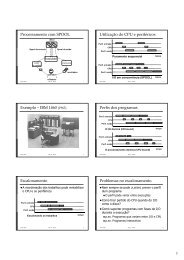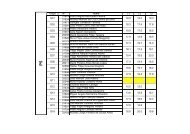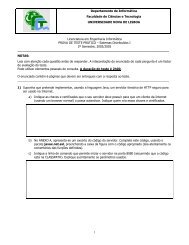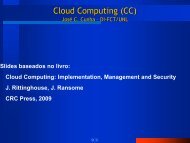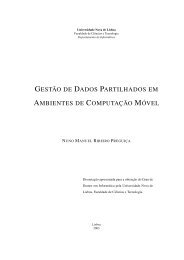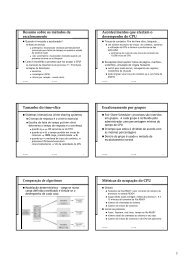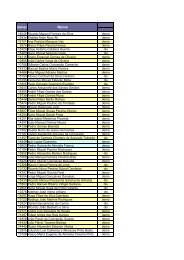Dissertaç ˜ao de Mestrado Mestrado em Engenharia Informática Jo ...
Dissertaç ˜ao de Mestrado Mestrado em Engenharia Informática Jo ...
Dissertaç ˜ao de Mestrado Mestrado em Engenharia Informática Jo ...
You also want an ePaper? Increase the reach of your titles
YUMPU automatically turns print PDFs into web optimized ePapers that Google loves.
B. APPENDIX - EVALUATION B.5. Performance Validation File 2<br />
# MAPNAME is the (otherwise freely chosen) map name that was used in<br />
# pg_hba.conf. IDENT-USERNAME is the <strong>de</strong>tected user name of the<br />
# client. PG-USERNAME is the requested PostgreSQL user name. The<br />
# existence of a record specifies that IDENT-USERNAME may connect as<br />
# PG-USERNAME. Multiple maps may be specified in this file and used<br />
# by pg_hba.conf.<br />
#<br />
# This file is read on server startup and when the postmaster<br />
receives<br />
# a SIGHUP signal. If you edit the file on a running syst<strong>em</strong>, you<br />
have<br />
# to SIGHUP the postmaster for the changes to take effect. You can<br />
use<br />
# "pg_ctl reload" to do that.<br />
# Put your actual configuration here<br />
# ----------------------------------<br />
#<br />
# No map names are <strong>de</strong>fined in the <strong>de</strong>fault configuration. If all<br />
i<strong>de</strong>nt<br />
# user names and PostgreSQL user names are the same, you don’t need<br />
# this file. Instead, use the special map name "sameuser" in<br />
# pg_hba.conf.<br />
# MAPNAME IDENT-USERNAME PG-USERNAME<br />
B.5 Performance Validation File 2<br />
# PostgreSQL Client Authentication Configuration File<br />
# ===================================================<br />
#<br />
# Refer to the "Client Authentication" section in the<br />
# PostgreSQL documentation for a complete <strong>de</strong>scription<br />
# of this file. A short synopsis follows.<br />
#<br />
# This file controls: which hosts are allowed to connect, how clients<br />
# are authenticated, which PostgreSQL user names they can use, which<br />
# databases they can access. Records take one of these forms:<br />
#<br />
# local DATABASE USER METHOD [OPTION]<br />
140



